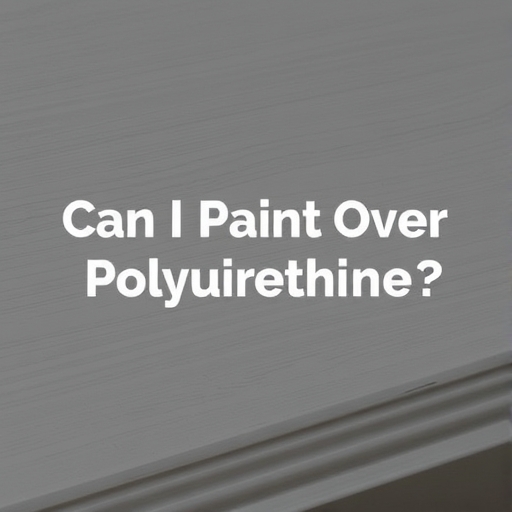Can I Paint Over Polyurethane? A Comprehensive Guide
Polyurethane is a popular finish for wood surfaces, providing a durable and protective layer. However, many homeowners and DIY enthusiasts wonder whether they can paint over polyurethane without compromising the finish. This article explores the ins and outs of painting over polyurethane, including preparation, techniques, and tips for achieving the best results.
Understanding Polyurethane
What is Polyurethane?
Polyurethane is a synthetic resin that forms a hard, protective layer when applied to wood surfaces. It is available in two main forms: oil-based and water-based, each with its unique properties and applications.
- Oil-Based Polyurethane:
- Provides a rich, amber tone to wood.
- Takes longer to dry and has a strong odor.
- More durable and resistant to scratches and heat.
- Water-Based Polyurethane:
- Dries quickly and has low odor.
- Maintains the natural color of wood.
- Easier to clean up and less toxic.
- Durability: Protects surfaces from scratches, water, and UV rays.
- Versatility: Suitable for various surfaces, including furniture, floors, and cabinetry.
- Aesthetic Appeal: Enhances the natural beauty of wood grains.
- Choose the Right Grit:
- Start with a medium-grit sandpaper (around 120-150 grit) to remove the glossy finish.
- Follow up with a fine-grit sandpaper (220 grit) to smooth out the surface.
- Technique:
- Sand in the direction of the wood grain.
- Be careful not to sand too deeply, as you may damage the wood underneath.
- Latex Paint: Generally, the best choice for water-based polyurethane surfaces. It provides excellent adhesion and flexibility.
- Oil-Based Paint: Works well over oil-based polyurethane, but be cautious of potential yellowing over time.
- Use a high-quality brush or roller for application.
- Apply thin, even coats to avoid drips and ensure a smooth finish.
- Allow each coat to dry completely before applying the next one.
- Test a Small Area: Before fully committing, test your paint and primer on a small, inconspicuous area to ensure compatibility.
- Use Quality Products: Invest in high-quality paint and primer for the best results.
- Work in a Well-Ventilated Area: Ensure proper ventilation to minimize fumes and speed up drying times.
- Consider Weather Conditions: Optimal temperature and humidity levels will affect drying times and paint performance.
Benefits of Polyurethane
Can You Paint Over Polyurethane?
The Short Answer
Yes, you can paint over polyurethane, but proper preparation is crucial to ensure good adhesion and a smooth finish.
Preparing to Paint Over Polyurethane
Step 1: Assess the Surface
Before you begin, evaluate the polyurethane finish. If the surface is in good condition and not peeling, you can proceed. If it shows signs of wear or damage, consider sanding it down or stripping it completely.
Step 2: Clean the Surface
Thoroughly clean the surface to remove dust, grease, and contaminants. Use a mixture of warm water and mild soap for cleaning, followed by a rinse with clean water. Allow the surface to dry completely.
Step 3: Sanding
Sanding is a critical step when painting over polyurethane. It creates a rough surface that promotes adhesion.
Step 4: Clean Again
After sanding, clean the surface again to remove any dust created during the sanding process. A vacuum or a damp cloth works well for this purpose.
Step 5: Prime the Surface (Optional)
While not always necessary, using a primer can help improve adhesion and provide a uniform surface for the paint. Choose a primer suitable for the type of paint you plan to use (oil-based or water-based).
Step 6: Choose the Right Paint
Painting Over Polyurethane
Step 1: Apply the Paint
Step 2: Sand Between Coats
For a smoother finish, lightly sand between coats of paint using fine-grit sandpaper (220 grit). This step helps to remove any imperfections and enhances adhesion.
Step 3: Final Coat
After applying the desired number of coats, inspect the finish. If you are satisfied with the coverage and appearance, you can stop here. Otherwise, you can apply additional coats as needed.
Tips for Success
Comparison Table: Oil-Based vs. Water-Based Polyurethane
| Feature | Oil-Based Polyurethane | Water-Based Polyurethane |
|---|---|---|
| Drying Time | 6-8 hours | 1-2 hours |
| Cleanup | Solvents required | Soap and water |
| Color | Amber tint | Clear |
| Durability | High | Moderate to high |
| Odor | Strong | Low |
| Application | Brush or roller | Brush, roller, or spray |
FAQ
Can I paint over a glossy polyurethane finish?
Yes, you can paint over a glossy finish, but it’s essential to sand the surface first to create a rough texture for better paint adhesion.
How long should I wait before painting over polyurethane?
It is advisable to wait at least 24-48 hours after applying a coat of polyurethane before attempting to paint over it. This allows the finish to cure adequately.
What if the paint starts to peel?
If the paint begins to peel, it may indicate insufficient surface preparation. In this case, you may need to sand down the painted surface and start over, ensuring proper cleaning and priming.
Can I use spray paint on polyurethane?
Yes, you can use spray paint on polyurethane surfaces. Ensure you follow the same preparation steps, including sanding and cleaning.
Is it better to use a primer before painting over polyurethane?
Using a primer is highly recommended as it enhances adhesion and provides a uniform surface for the paint, especially when working with different types of polyurethane finishes.
Conclusion
Painting over polyurethane can be a straightforward process if you take the time to prepare properly. By following the steps outlined in this guide—cleaning, sanding, priming, and choosing the right paint—you can achieve beautiful results that enhance the appearance of your wood surfaces. Whether you’re refreshing a piece of furniture or transforming cabinetry, understanding how to work with polyurethane finishes will ensure your project is a success. Happy painting!

